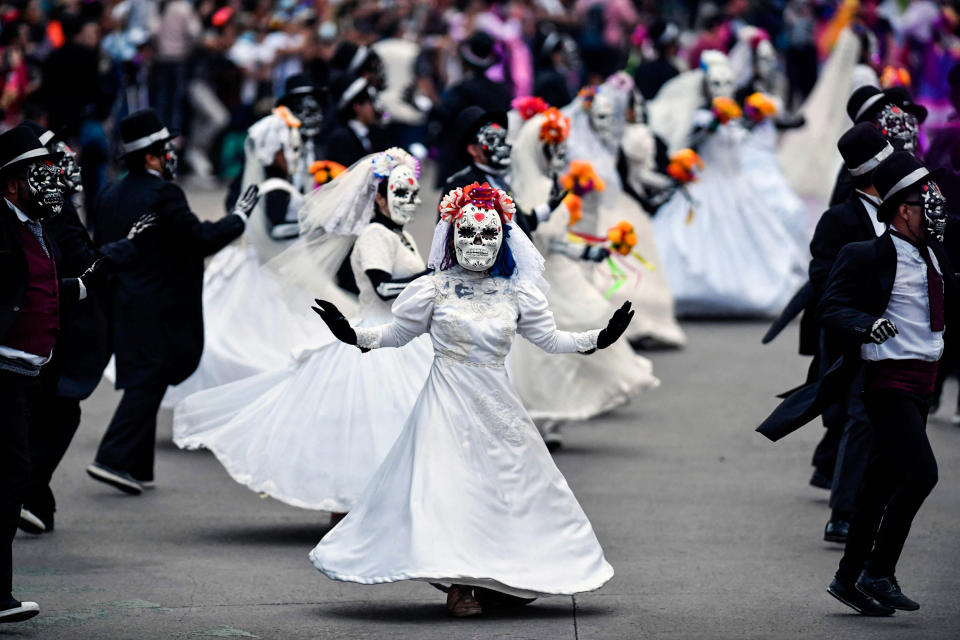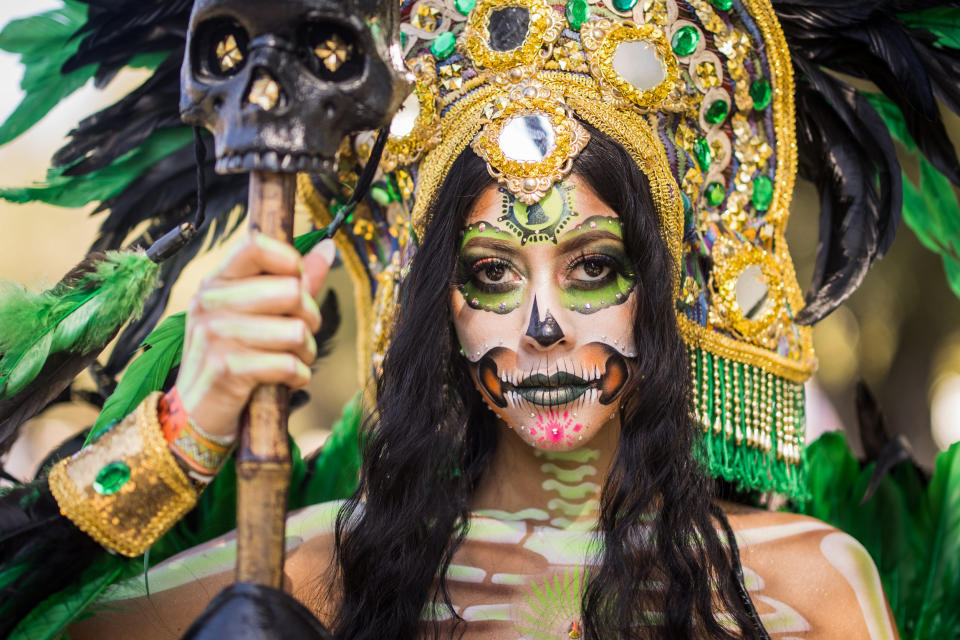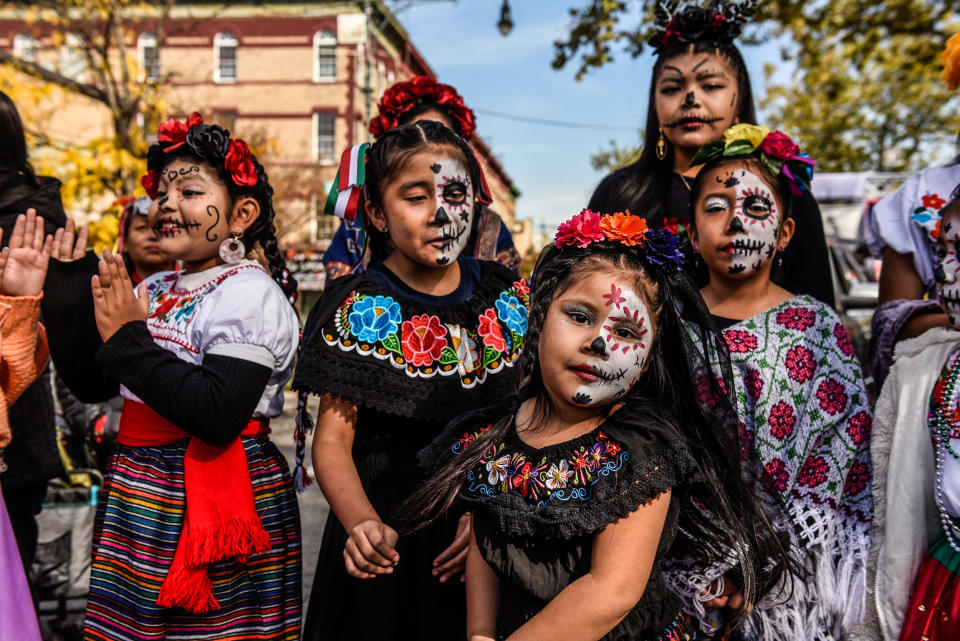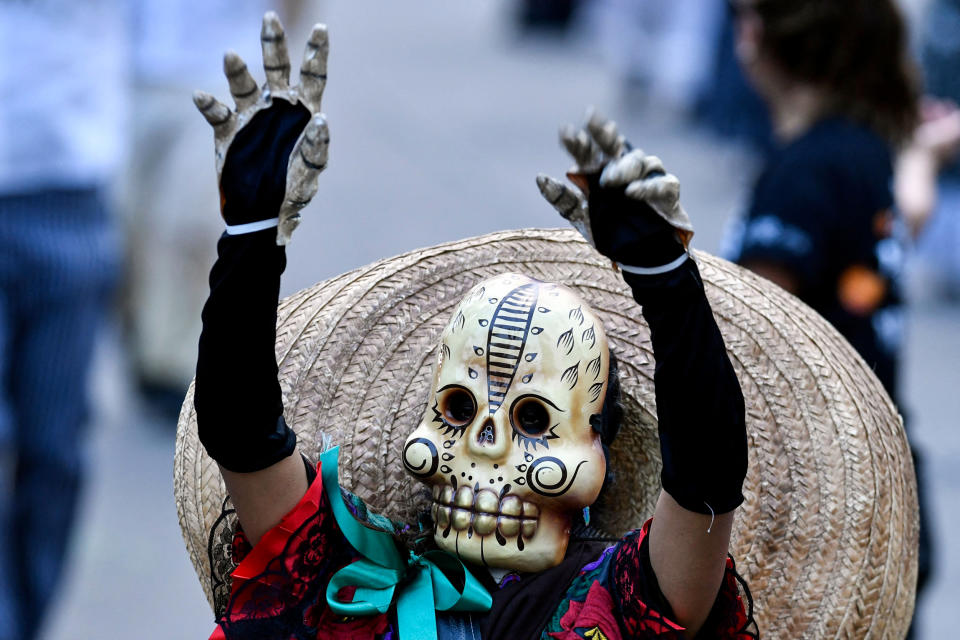What is Day of the Dead and why does Día de los Muertos endure?
MEXICO CITY — José García López was sweating profusely as he stirred a cauldron of boiling oil in which dozens of potatoes were swimming, though his mind, he said, was on something else.
“When I’m done I’m going to buy the paper and candles that I need; I can’t let my grandparents down,” he said Friday afternoon, referring to the decorations he's going to make to honor his deceased relatives, as he spoke on the sidewalk of the Panteón Francés de la Piedad, an old cemetery in Mexico City.
García López is a street vendor who, like millions of Mexicans inside and outside the country, was getting ready to celebrate Día de los Muertos, or the Day of the Dead, a holiday in which Indigenous and Catholic traditions blend to honor loved ones who have died.
"I like that Mexicans do not forget our dead. In that way we are different," he said. "We live here, while relatives remember us."
The idea is magical and powerful: celebrating the dead for a few days while their souls return to Earth to share with the living. Nov. 1 honors deceased children and Nov. 2 focuses on adults.

"In Mexico, Nov. 1 and 2 are very special days because they celebrate All Saints’ Day and All Souls’ Day, respectively," said Diana Martínez, an academic at the Institute of Anthropological Research at the National Autonomous University of Mexico, or UNAM.
Día de los Muertos is celebrated not just across Mexico, but also in U.S. cities such as Los Angeles and New York, where large offerings, parades and cultural events are held. Countries like Spain, the Philippines, Brazil and Guatemala, among others, also have traditions to celebrate their deceased.
Both public places and homes are filled with altars or offerings to commemorate loved ones with their favorite things, and decorations include cempasúchil flowers (marigolds), paper cut-outs, candles, salt, water, chocolate, sugar skulls, pan de muerto (bread of the dead) and the favorite foods and liquor of the deceased.
"It is a purely Catholic tradition that the Spaniards bring to Mexico and merges with the entire worldview or form of Mesoamerican thought. It is a festival that gives us belonging and unites us," Martínez said.
Popular beliefs vary depending on the Mexican region. Apart from Nov. 1 and 2, Oct. 28 is celebrated for those who died tragically or accidentally, and Oct. 30 is dedicated to those who died without being baptized and are in limbo.
From the 11th century to 'Coco' and 'Spectre'
The festivity dates back to the 11th century, when the abbot of Cluny created a special day to honor believers who died when Christianity was still considered a sect and persecutions and executions were frequent. By the 13th century, the Roman Catholic Church established Nov. 1 as All Saints’ Day.
In Spain, "the kingdoms of León, Aragón and Castile prepared sweets and breads similar to relics, which are the remains or bones of saints," Martínez said.
This ritual was combined with ancient festivals related to the end of the rainy season, harvest and drought. "It is that duality of abundance and scarcity, of life and death," she said.
Since before Spaniards and Christianity came to Latin America, Indigenous groups such as the Nahuas established rites and festivals that celebrated the deceased, as is the case of Miccailhuitontli, the Aztec Festival of the Little Dead.

The ancient Mexicans considered death a transition, not the end of existence but the beginning of the journey to Mictlan, the place of eternal rest in Aztec mythology.
Following the Mexican Revolution and the first years of independence, what it meant to be Mexican was re-evaluated, Martínez said, and that promoted a series of traditions such as the Day of the Dead. In the 1930s, President Lázaro Cárdenas promoted the celebration, trying to distance it a little from the Catholic Church and emphasizing its Indigenous, pre-Hispanic roots.
In 2008, UNESCO declared Día de los Muertos an Intangible Cultural Heritage of Humanity, and in recent years it has transcended borders, becoming a cultural phenomenon enhanced by movies such as Pixar's "Coco," which grossed more than $800 million worldwide.
The Day of the Dead was prominent in the memorable opening scene of the 2015 James Bond movie "Spectre," in which actor Daniel Craig seduces a catrina — the female skeleton — while running, jumping, shooting and exploding a building in the Historic Center of Mexico City during the Día de los Muertos parade.
It's a case in which reality imitates fiction because that parade had never been done, but now it's celebrated every year; in 2021 over 400,000 people participated.
"There are people who say that this is pure cultural marketing, but they don't understand that culture is culture because it changes, adapts and transforms," said Enrique Rodríguez Balam, a researcher at UNAM'S Peninsular Center for Humanities and Social Sciences in Mérida, Yucatán. "For me it is a triumph that this parade is popular and brings together thousands of people."
Altars, dancing, even cleaning bones
From Oct. 28, offerings begin to be made at altars, both public and private, and of all sizes. Although there are variations, there seems to be a consensus among experts about the shape of the altars: They are three steps or levels that, from bottom to top, represent the underworld, the earthly plane and the upper stage.
"Although it began with the saints and the faithful departed, now it has become popular to put movie stars, grandparents, saints and even pets," Martínez said. "In general, the offerings contain salt, water, copal (tree resin), candles, flowers, papel picado (paper cut-outs), skulls, photographs of loved ones and the deceased’s favorite dishes. Depending on the region there are changes. For example, in the Huasteca arches with flowers and fruits are placed that invite the dead to enter to the earthly world."
According to the National Institute of Indigenous Peoples, each element has a specific meaning.
Water is a symbol of life and is included so that the souls recover after their long journey. Since ancient times, salt has been an element of purification because, among other things, it helps prevent bodies from becoming corrupted.

The candles are light and guide the souls so they can return to their old places: The number of candles on the altar will depend on the souls that the family wants to receive. If the candles are placed in the shape of a cross, they represent the cardinal points so that souls can find their way home.
Copal or incense is used to cleanse places of evil spirits. In general, flowers adorn the room of the soul; marigolds are stripped in some places to make paths of petals and guide the deceased to the offering.
The izcuintle dog helps the souls to cross the powerful river before entering Mictlan. Bread is a Christian element that symbolizes "the Body of Christ," according to the Institute. Portraits of loved ones are the physical representation of those who are no longer on Earth, and their favorite dishes are also part of the celebration.
Some practices include making altars on tombstones. In some towns in Mexico there are dances with masks; it's believed that the souls of the dead temporarily take over the bodies of the living. In some towns in Guatemala, the celebrations lead to parties where people end up singing in cemeteries among the dead.
Few celebrations are as peculiar as those that take place in the Pomuch cemetery, in the Mexican state of Campeche, where the Cleaning of the Holy Remains takes place. In that town, the remains of loved ones rest in boxes at the cemetery and, every year, people gather to clean their relatives' bones.
'A beautiful tradition'
Mexican culture's fascination with and respect for death has been a recurring motif in the country’s literary tradition. Important writers such as José Revueltas, Carlos Fuentes, Octavio Paz and Juan Rulfo have reflected on this in their works.
"What is a fact is that the Mexican's obsession with mixing death with a celebration of rituals and daily life is something very much ours," Rodríguez Balam said, "and that is what draws attention in other parts of the world."

Raúl Flores, 57, is a gravedigger at the Panteón Francés de la Piedad cemetery. He lives among the bowels of the Earth where everything changes, even the notion of time — he measures time by how long it takes to dig pits.
“In this job we deal with so many things, and, in the end, death is something very, very common, right? It’s just one more step that all people, rich and poor, have to go through,” he said.
He's worked at the cemetery from a very young age and has witnessed many Día de los Muertos celebrations.
"It is a beautiful tradition, because people remember their grandparents, their parents, their brothers," he said. "It is not sad. Rather many times they look happy when they make the altars. People think that cemeteries are scary, but no. They are the quietest places."
An earlier version of this story was first published on Noticias Telemundo.
Follow NBC Latino on Facebook, Twitter and Instagram.
This article was originally published on NBCNews.com
